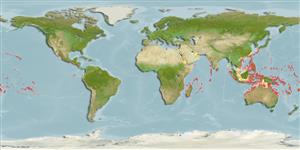Actinopterygii (ray-finned fishes) >
Perciformes (Perch-likes) >
Gobiidae (Gobies) > Gobiinae
Etymology: Callogobius: Greek, kalos, kallos = beautiful + Latin, gobius = gudgeon (Ref. 45335).
Environment / Climate / Range
Ecology
Marine; reef-associated; depth range 1 - 37 m (Ref. 86942). Tropical, preferred ?; 32°N - 28°S
Indo-Pacific: East Africa to the Society Islands, north to southern Japan, south to Queensland; Mariana, Kapingamarangi (?), and Marshall Islands in Micronesia.
Size / Weight / Age
Maturity: Lm ? range ? - ? cm
Max length : 7.0 cm TL male/unsexed; (Ref. 11344)
Dorsal
spines
(total): 7;
Dorsal
soft rays
(total): 9;
Anal
spines: 1;
Anal
soft rays: 7. Dark bar from eye to upper lip, vertical bar under eye, broad dark band from eye to opercle; vertical bar under first dorsal fin; caudal fin with wavy dark stripes (Ref. 2798); characterized further by pale brown to whitish body color; variably joined pelvic fins at median from base to about two-thirds length of fifth ray; pelvic frenum absent; very long and pointed caudal fin; longitudinal scale series 63-67; cycloid scales on head and anterior body; becoming ctenoid posteriorly; cycloid scales on cheek and opercle; predorsal scales 11, extending to interorbital space; head with prominent papillae ridges; depth of body 4.7-5.5 in SL (Ref. 90102).
Found in crevices and caves (Ref. 2334, 9360), usually under loose debris (Ref. 48637).
Life cycle and mating behavior
Maturity | Reproduction | Spawning | Eggs | Fecundity | Larvae
Myers, R.F., 1991. Micronesian reef fishes. Second Ed. Coral Graphics, Barrigada, Guam. 298 p. (Ref. 1602)
IUCN Red List Status (Ref. 115185)
CITES (Ref. 94142)
Not Evaluated
Threat to humans
Harmless
Human uses
More information
Common namesSynonymsMetabolismPredatorsEcotoxicologyReproductionMaturitySpawningFecundityEggsEgg development
ReferencesAquacultureAquaculture profileStrainsGeneticsAllele frequenciesHeritabilityDiseasesProcessingMass conversion
Tools
Special reports
Download XML
Internet sources
Estimates of some properties based on models
Phylogenetic diversity index (Ref.
82805): PD
50 = 0.5000 [Uniqueness, from 0.5 = low to 2.0 = high].
Trophic Level (Ref.
69278): 3.3 ±0.3 se; Based on size and trophs of closest relatives
Resilience (Ref.
69278): High, minimum population doubling time less than 15 months (Preliminary K or Fecundity.).
Vulnerability (Ref.
59153): Low vulnerability (15 of 100) .
